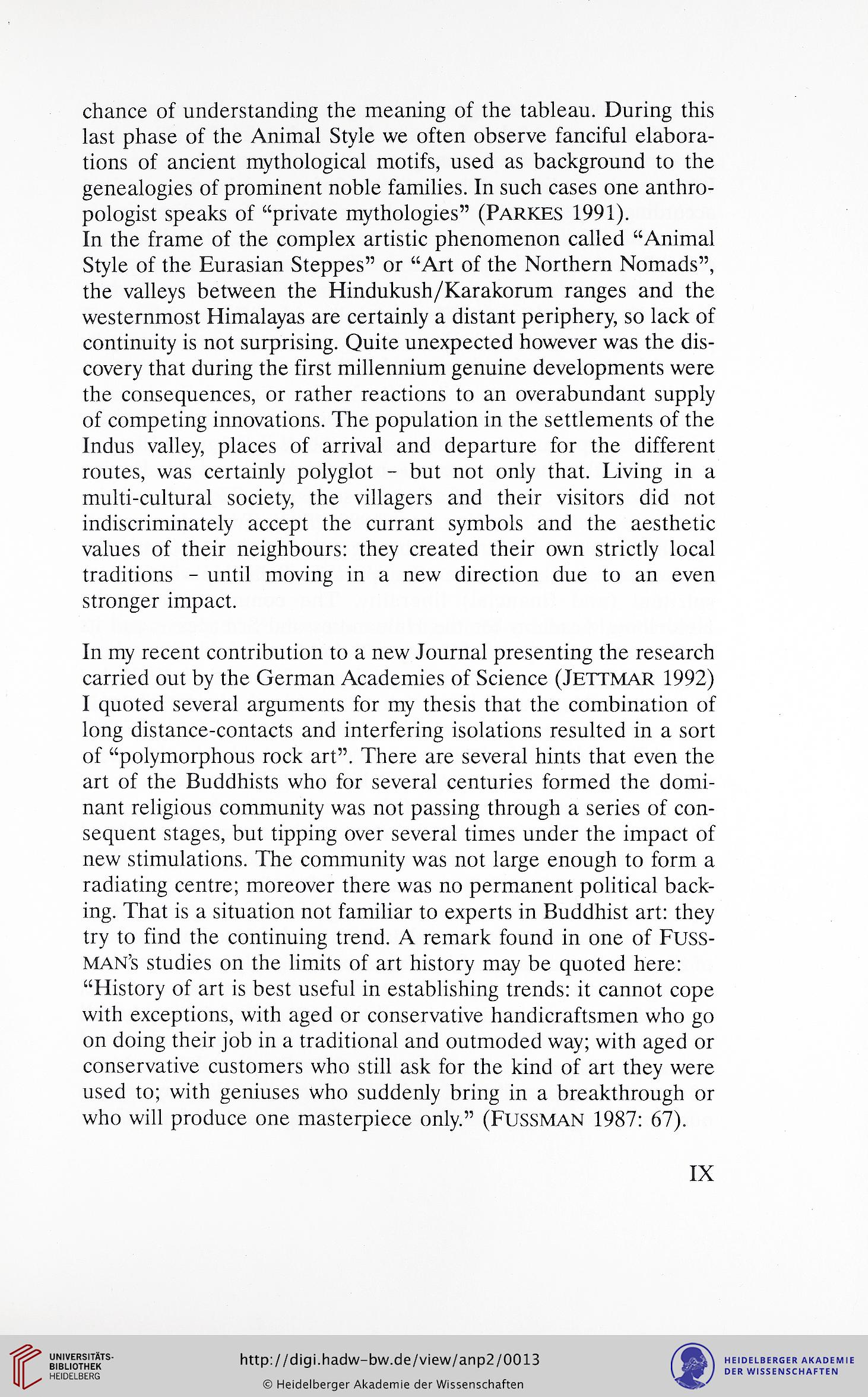chance of understanding the meaning of the tableau. During this
last phase of the Animal Style we often observe fanciful elabora-
tions of ancient mythological motifs, used as background to the
genealogies of prominent noble families. In such cases one anthro-
pologist speaks of "private mythologies" (PARKES 1991).
In the frame of the complex artistic phenomenon called "Animal
Style of the Eurasian Steppes" or "Art of the Northern Nomads",
the valleys between the Hindukush/Karakorum ranges and the
westernmost Himalayas are certainly a distant periphery, so lack of
continuity is not surprising. Quite unexpected however was the dis-
covery that during the first millennium genuine developments were
the consequences, or rather reactions to an overabundant supply
of competing innovations. The population in the settlements of the
Indus valley, places of arrival and departure for the different
routes, was certainly polyglot - but not only that. Living in a
multi-cultural society, the villagers and their visitors did not
indiscriminately accept the currant symbols and the aesthetic
values of their neighbours: they created their own strictly local
traditions - until moving in a new direction due to an even
stronger impact.
In my recent contribution to a new Journal presenting the research
carried out by the German Academies of Science (JETTMAR 1992)
I quoted several arguments for my thesis that the combination of
long distance-contacts and interfering isolations resulted in a sort
of "polymorphous rock art". There are several hints that even the
art of the Buddhists who for several centuries formed the domi-
nant religious community was not passing through a series of con-
sequent stages, but tipping over several times under the impact of
new stimulations. The community was not large enough to form a
radiating centre; moreover there was no permanent political back-
ing. That is a situation not familiar to experts in Buddhist art: they
try to find the continuing trend. A remark found in one of FUSS-
MAN's studies on the limits of art history may be quoted here:
"History of art is best useful in establishing trends: it cannot cope
with exceptions, with aged or conservative handicraftsmen who go
on doing their job in a traditional and outmoded way; with aged or
conservative customers who still ask for the kind of art they were
used to; with geniuses who suddenly bring in a breakthrough or
who will produce one masterpiece only." (FUSSMAN 1987: 67).
IX
last phase of the Animal Style we often observe fanciful elabora-
tions of ancient mythological motifs, used as background to the
genealogies of prominent noble families. In such cases one anthro-
pologist speaks of "private mythologies" (PARKES 1991).
In the frame of the complex artistic phenomenon called "Animal
Style of the Eurasian Steppes" or "Art of the Northern Nomads",
the valleys between the Hindukush/Karakorum ranges and the
westernmost Himalayas are certainly a distant periphery, so lack of
continuity is not surprising. Quite unexpected however was the dis-
covery that during the first millennium genuine developments were
the consequences, or rather reactions to an overabundant supply
of competing innovations. The population in the settlements of the
Indus valley, places of arrival and departure for the different
routes, was certainly polyglot - but not only that. Living in a
multi-cultural society, the villagers and their visitors did not
indiscriminately accept the currant symbols and the aesthetic
values of their neighbours: they created their own strictly local
traditions - until moving in a new direction due to an even
stronger impact.
In my recent contribution to a new Journal presenting the research
carried out by the German Academies of Science (JETTMAR 1992)
I quoted several arguments for my thesis that the combination of
long distance-contacts and interfering isolations resulted in a sort
of "polymorphous rock art". There are several hints that even the
art of the Buddhists who for several centuries formed the domi-
nant religious community was not passing through a series of con-
sequent stages, but tipping over several times under the impact of
new stimulations. The community was not large enough to form a
radiating centre; moreover there was no permanent political back-
ing. That is a situation not familiar to experts in Buddhist art: they
try to find the continuing trend. A remark found in one of FUSS-
MAN's studies on the limits of art history may be quoted here:
"History of art is best useful in establishing trends: it cannot cope
with exceptions, with aged or conservative handicraftsmen who go
on doing their job in a traditional and outmoded way; with aged or
conservative customers who still ask for the kind of art they were
used to; with geniuses who suddenly bring in a breakthrough or
who will produce one masterpiece only." (FUSSMAN 1987: 67).
IX





